Woolworths' Plastic Bag Ban: Consumer Response and Marketing Research
VerifiedAdded on 2023/06/05
|15
|2701
|325
Report
AI Summary
This report investigates the marketing implications of Woolworths' decision to ban lightweight plastic bags, examining consumer responses and the potential impact on sales and profitability. The research uses a descriptive design, employing a deductive approach to analyze the outrage and uproar surrounding the ban. Data collection involves both primary and secondary methods, with a focus on quantitative analysis through questionnaires to gauge staff perspectives. Ethical considerations, including data protection, are emphasized to ensure respondent privacy and research integrity. The report also discusses combating plastic bag usage in Australia, highlighting limitations and findings related to waste management and environmental pollution. Ultimately, the research provides recommendations for restoring normalcy and preserving ecological diversity in light of the ban. Desklib offers a wealth of similar solved assignments and study resources for students.
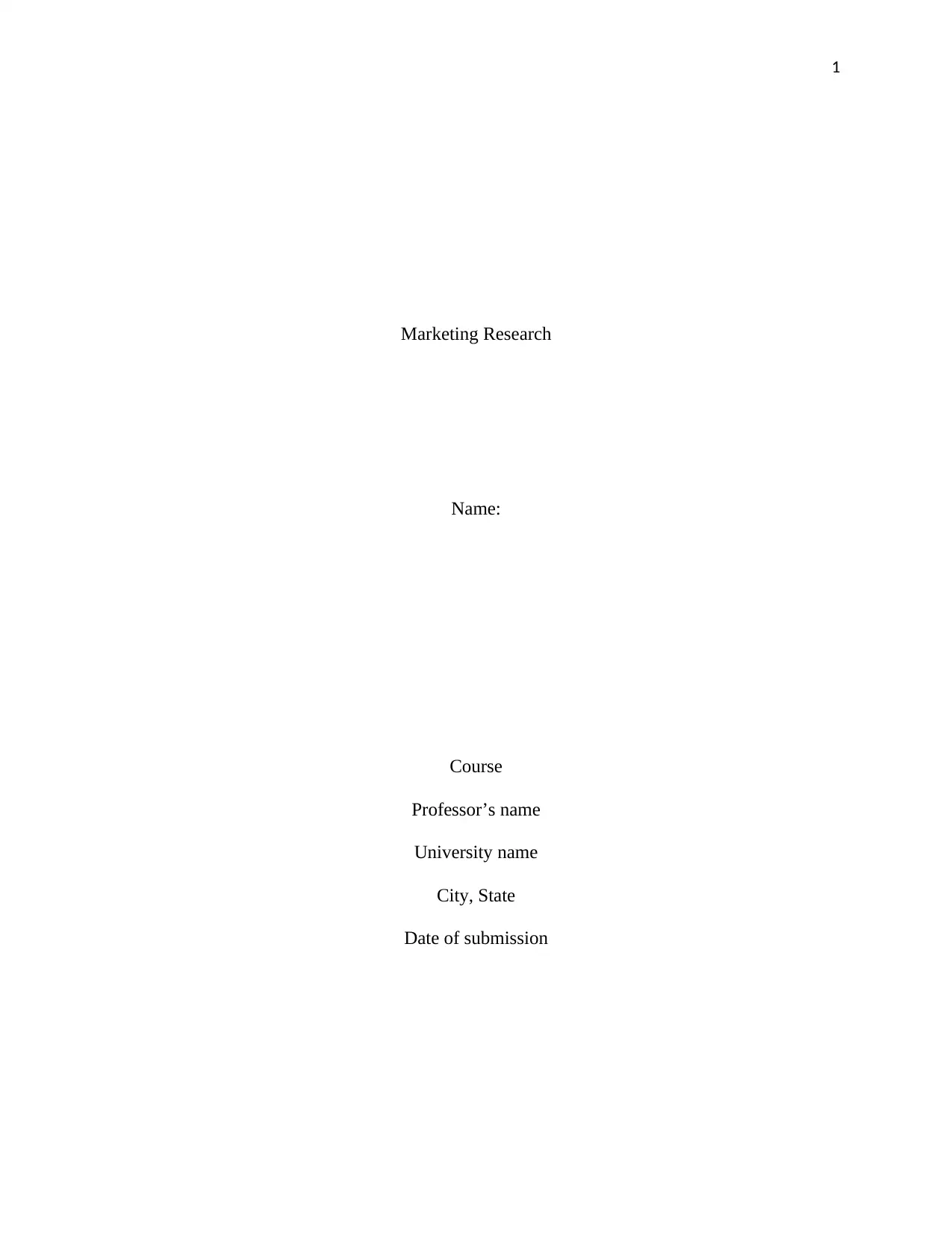
1
Marketing Research
Name:
Course
Professor’s name
University name
City, State
Date of submission
Marketing Research
Name:
Course
Professor’s name
University name
City, State
Date of submission
Paraphrase This Document
Need a fresh take? Get an instant paraphrase of this document with our AI Paraphraser
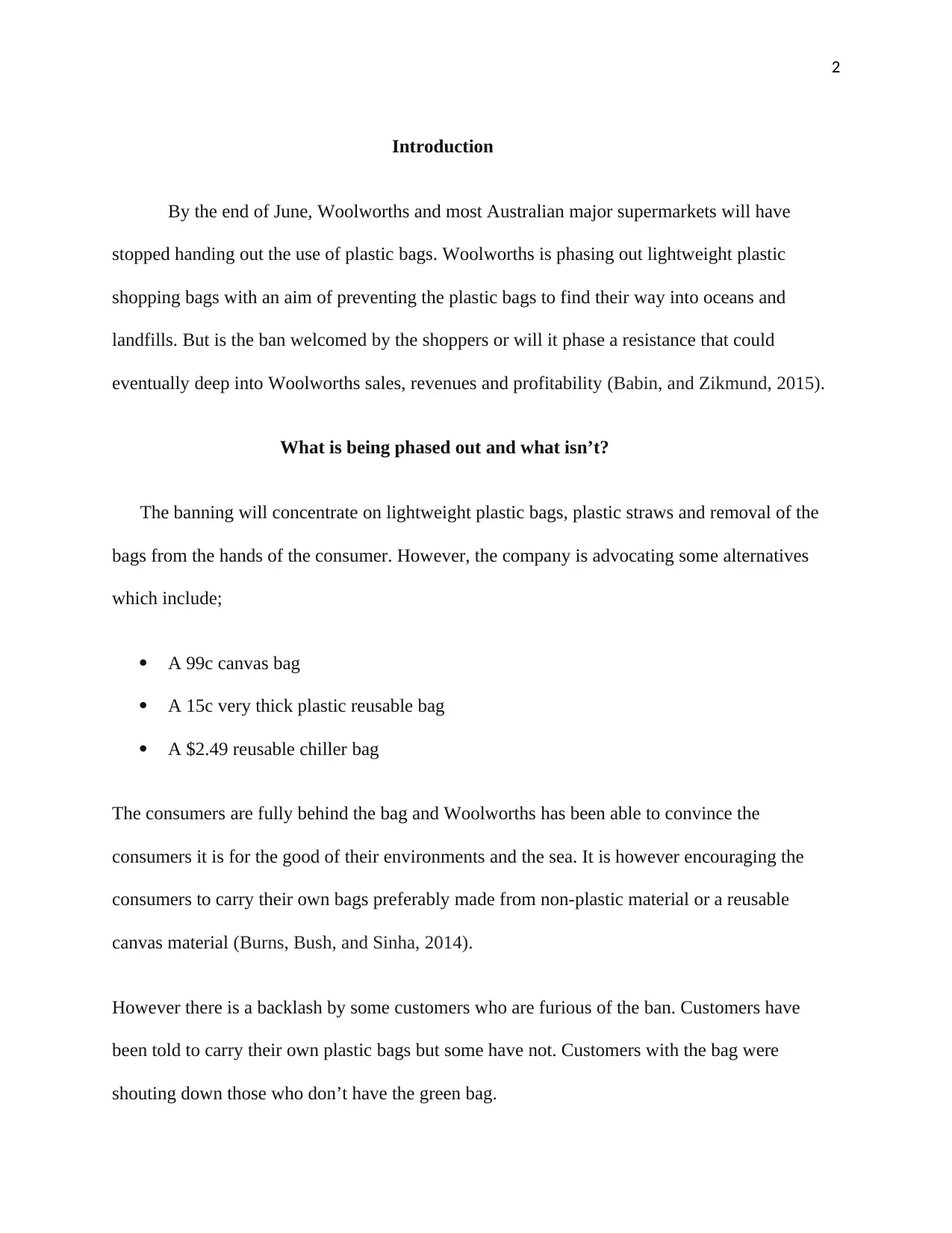
2
Introduction
By the end of June, Woolworths and most Australian major supermarkets will have
stopped handing out the use of plastic bags. Woolworths is phasing out lightweight plastic
shopping bags with an aim of preventing the plastic bags to find their way into oceans and
landfills. But is the ban welcomed by the shoppers or will it phase a resistance that could
eventually deep into Woolworths sales, revenues and profitability (Babin, and Zikmund, 2015).
What is being phased out and what isn’t?
The banning will concentrate on lightweight plastic bags, plastic straws and removal of the
bags from the hands of the consumer. However, the company is advocating some alternatives
which include;
A 99c canvas bag
A 15c very thick plastic reusable bag
A $2.49 reusable chiller bag
The consumers are fully behind the bag and Woolworths has been able to convince the
consumers it is for the good of their environments and the sea. It is however encouraging the
consumers to carry their own bags preferably made from non-plastic material or a reusable
canvas material (Burns, Bush, and Sinha, 2014).
However there is a backlash by some customers who are furious of the ban. Customers have
been told to carry their own plastic bags but some have not. Customers with the bag were
shouting down those who don’t have the green bag.
Introduction
By the end of June, Woolworths and most Australian major supermarkets will have
stopped handing out the use of plastic bags. Woolworths is phasing out lightweight plastic
shopping bags with an aim of preventing the plastic bags to find their way into oceans and
landfills. But is the ban welcomed by the shoppers or will it phase a resistance that could
eventually deep into Woolworths sales, revenues and profitability (Babin, and Zikmund, 2015).
What is being phased out and what isn’t?
The banning will concentrate on lightweight plastic bags, plastic straws and removal of the
bags from the hands of the consumer. However, the company is advocating some alternatives
which include;
A 99c canvas bag
A 15c very thick plastic reusable bag
A $2.49 reusable chiller bag
The consumers are fully behind the bag and Woolworths has been able to convince the
consumers it is for the good of their environments and the sea. It is however encouraging the
consumers to carry their own bags preferably made from non-plastic material or a reusable
canvas material (Burns, Bush, and Sinha, 2014).
However there is a backlash by some customers who are furious of the ban. Customers have
been told to carry their own plastic bags but some have not. Customers with the bag were
shouting down those who don’t have the green bag.
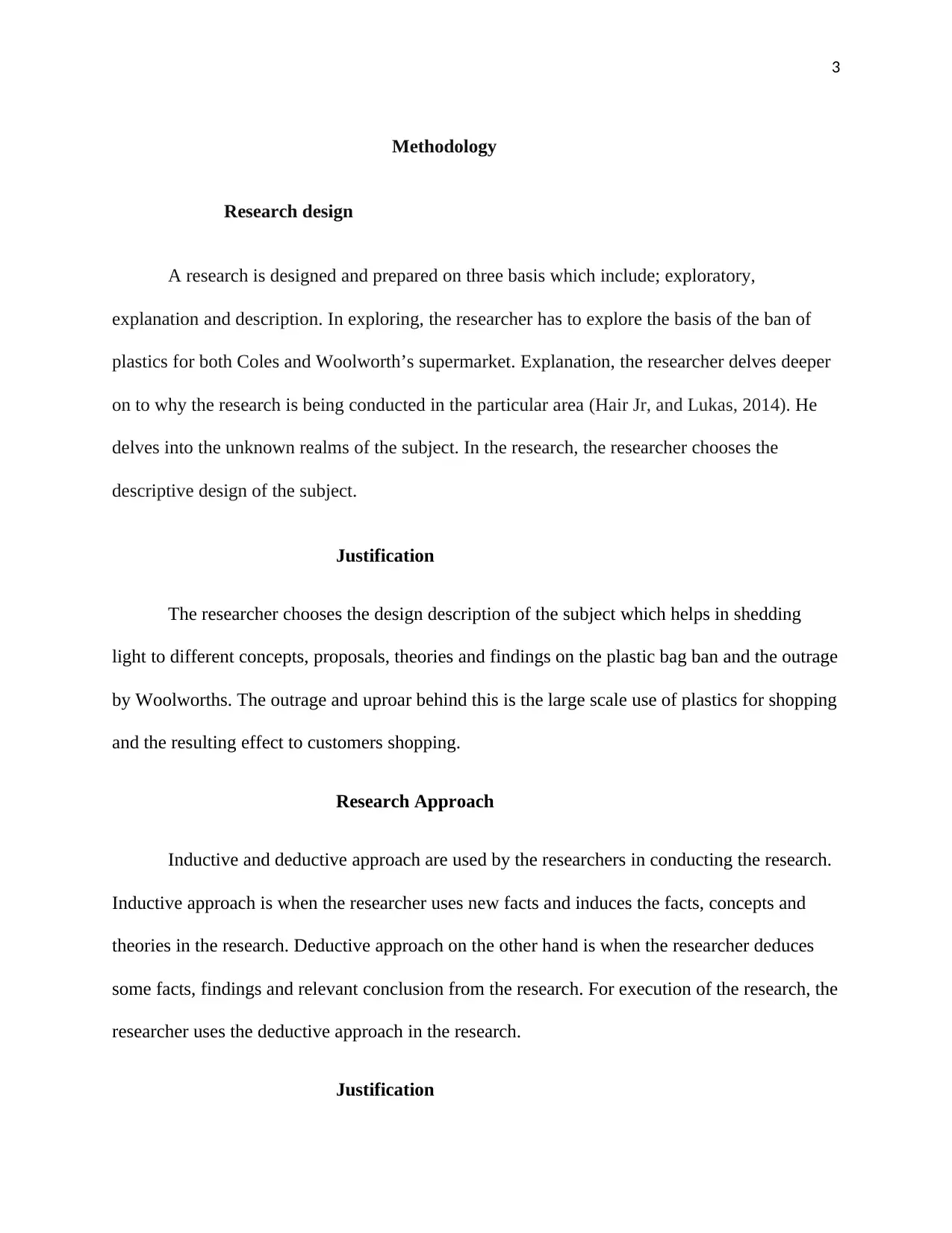
3
Methodology
Research design
A research is designed and prepared on three basis which include; exploratory,
explanation and description. In exploring, the researcher has to explore the basis of the ban of
plastics for both Coles and Woolworth’s supermarket. Explanation, the researcher delves deeper
on to why the research is being conducted in the particular area (Hair Jr, and Lukas, 2014). He
delves into the unknown realms of the subject. In the research, the researcher chooses the
descriptive design of the subject.
Justification
The researcher chooses the design description of the subject which helps in shedding
light to different concepts, proposals, theories and findings on the plastic bag ban and the outrage
by Woolworths. The outrage and uproar behind this is the large scale use of plastics for shopping
and the resulting effect to customers shopping.
Research Approach
Inductive and deductive approach are used by the researchers in conducting the research.
Inductive approach is when the researcher uses new facts and induces the facts, concepts and
theories in the research. Deductive approach on the other hand is when the researcher deduces
some facts, findings and relevant conclusion from the research. For execution of the research, the
researcher uses the deductive approach in the research.
Justification
Methodology
Research design
A research is designed and prepared on three basis which include; exploratory,
explanation and description. In exploring, the researcher has to explore the basis of the ban of
plastics for both Coles and Woolworth’s supermarket. Explanation, the researcher delves deeper
on to why the research is being conducted in the particular area (Hair Jr, and Lukas, 2014). He
delves into the unknown realms of the subject. In the research, the researcher chooses the
descriptive design of the subject.
Justification
The researcher chooses the design description of the subject which helps in shedding
light to different concepts, proposals, theories and findings on the plastic bag ban and the outrage
by Woolworths. The outrage and uproar behind this is the large scale use of plastics for shopping
and the resulting effect to customers shopping.
Research Approach
Inductive and deductive approach are used by the researchers in conducting the research.
Inductive approach is when the researcher uses new facts and induces the facts, concepts and
theories in the research. Deductive approach on the other hand is when the researcher deduces
some facts, findings and relevant conclusion from the research. For execution of the research, the
researcher uses the deductive approach in the research.
Justification
⊘ This is a preview!⊘
Do you want full access?
Subscribe today to unlock all pages.

Trusted by 1+ million students worldwide
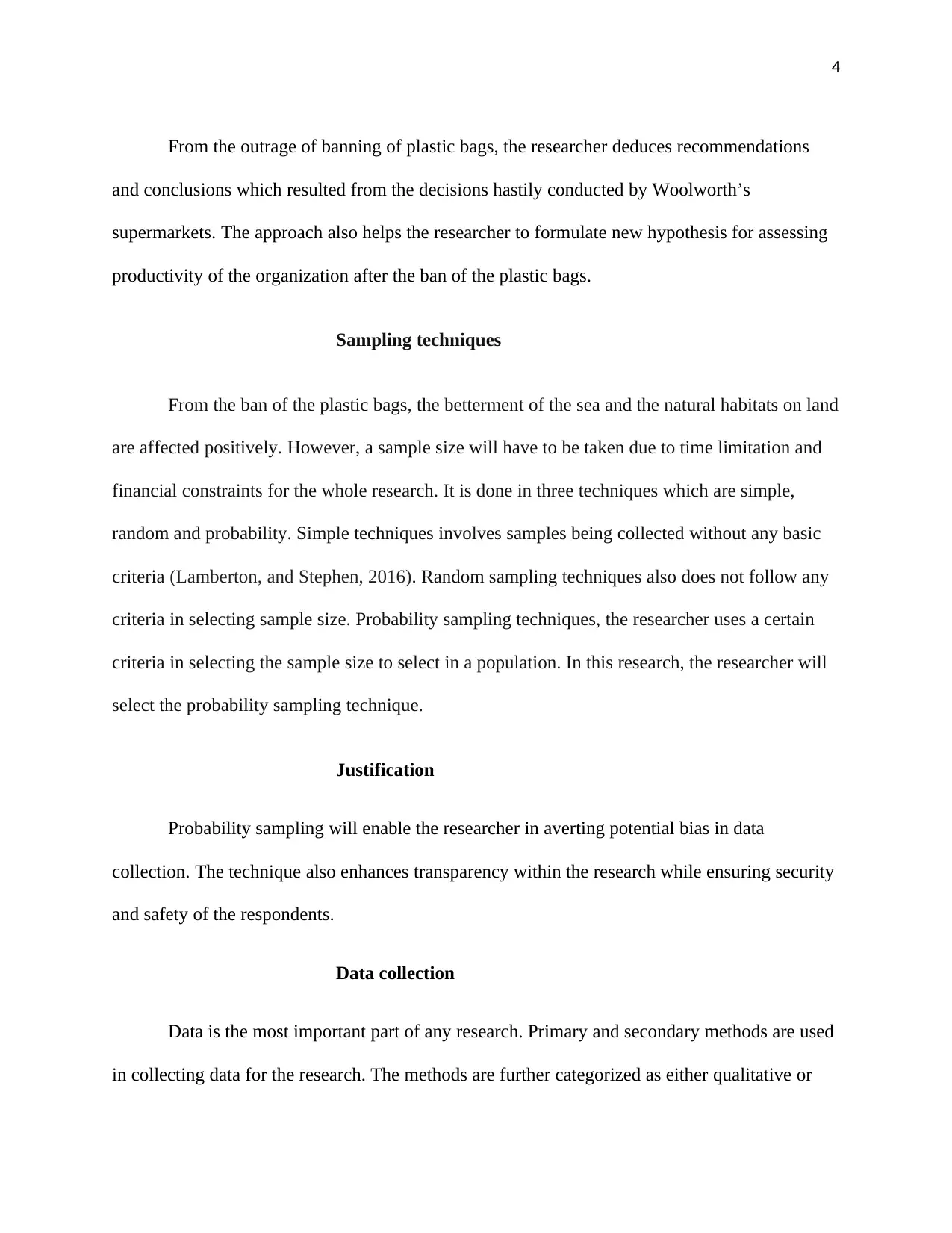
4
From the outrage of banning of plastic bags, the researcher deduces recommendations
and conclusions which resulted from the decisions hastily conducted by Woolworth’s
supermarkets. The approach also helps the researcher to formulate new hypothesis for assessing
productivity of the organization after the ban of the plastic bags.
Sampling techniques
From the ban of the plastic bags, the betterment of the sea and the natural habitats on land
are affected positively. However, a sample size will have to be taken due to time limitation and
financial constraints for the whole research. It is done in three techniques which are simple,
random and probability. Simple techniques involves samples being collected without any basic
criteria (Lamberton, and Stephen, 2016). Random sampling techniques also does not follow any
criteria in selecting sample size. Probability sampling techniques, the researcher uses a certain
criteria in selecting the sample size to select in a population. In this research, the researcher will
select the probability sampling technique.
Justification
Probability sampling will enable the researcher in averting potential bias in data
collection. The technique also enhances transparency within the research while ensuring security
and safety of the respondents.
Data collection
Data is the most important part of any research. Primary and secondary methods are used
in collecting data for the research. The methods are further categorized as either qualitative or
From the outrage of banning of plastic bags, the researcher deduces recommendations
and conclusions which resulted from the decisions hastily conducted by Woolworth’s
supermarkets. The approach also helps the researcher to formulate new hypothesis for assessing
productivity of the organization after the ban of the plastic bags.
Sampling techniques
From the ban of the plastic bags, the betterment of the sea and the natural habitats on land
are affected positively. However, a sample size will have to be taken due to time limitation and
financial constraints for the whole research. It is done in three techniques which are simple,
random and probability. Simple techniques involves samples being collected without any basic
criteria (Lamberton, and Stephen, 2016). Random sampling techniques also does not follow any
criteria in selecting sample size. Probability sampling techniques, the researcher uses a certain
criteria in selecting the sample size to select in a population. In this research, the researcher will
select the probability sampling technique.
Justification
Probability sampling will enable the researcher in averting potential bias in data
collection. The technique also enhances transparency within the research while ensuring security
and safety of the respondents.
Data collection
Data is the most important part of any research. Primary and secondary methods are used
in collecting data for the research. The methods are further categorized as either qualitative or
Paraphrase This Document
Need a fresh take? Get an instant paraphrase of this document with our AI Paraphraser
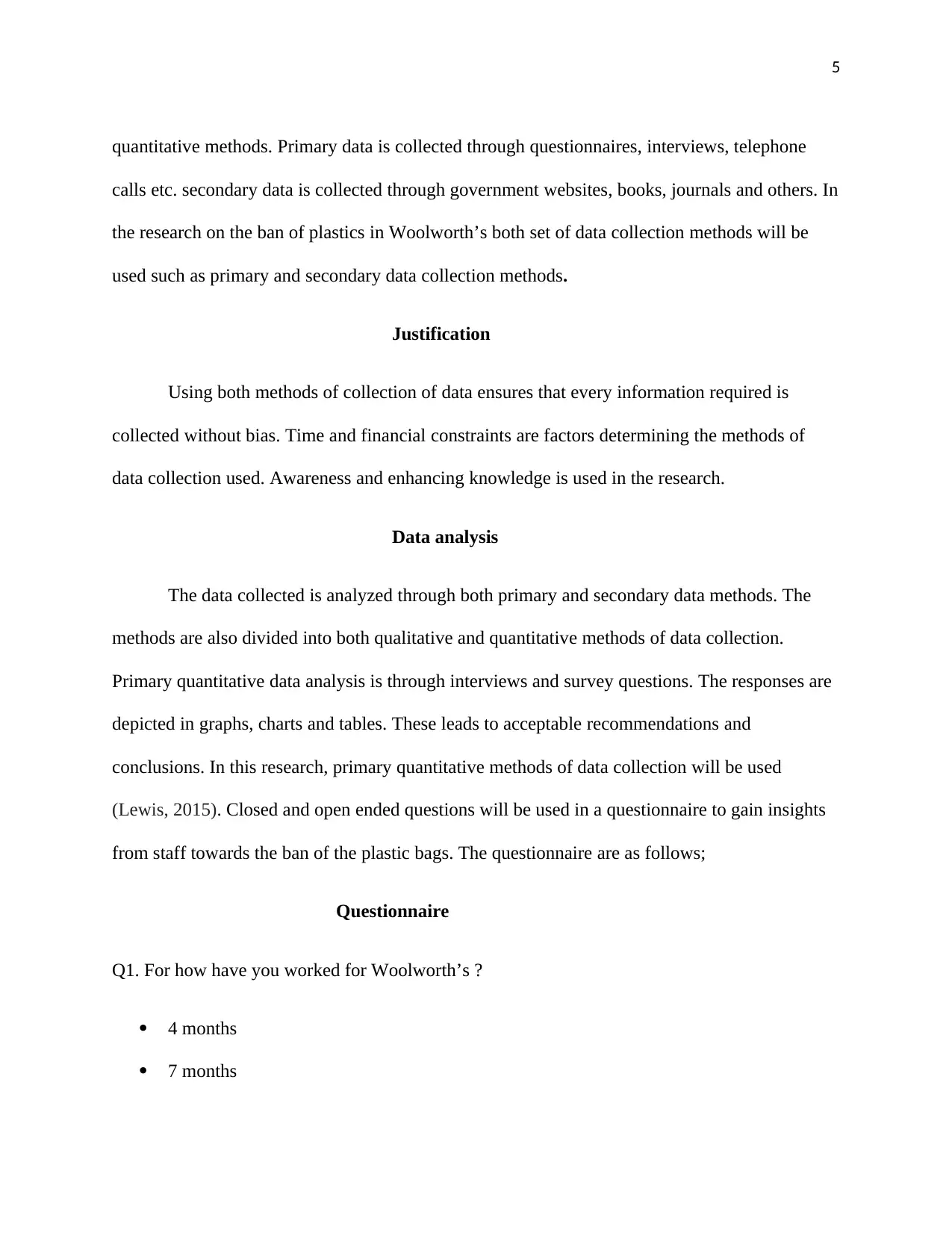
5
quantitative methods. Primary data is collected through questionnaires, interviews, telephone
calls etc. secondary data is collected through government websites, books, journals and others. In
the research on the ban of plastics in Woolworth’s both set of data collection methods will be
used such as primary and secondary data collection methods.
Justification
Using both methods of collection of data ensures that every information required is
collected without bias. Time and financial constraints are factors determining the methods of
data collection used. Awareness and enhancing knowledge is used in the research.
Data analysis
The data collected is analyzed through both primary and secondary data methods. The
methods are also divided into both qualitative and quantitative methods of data collection.
Primary quantitative data analysis is through interviews and survey questions. The responses are
depicted in graphs, charts and tables. These leads to acceptable recommendations and
conclusions. In this research, primary quantitative methods of data collection will be used
(Lewis, 2015). Closed and open ended questions will be used in a questionnaire to gain insights
from staff towards the ban of the plastic bags. The questionnaire are as follows;
Questionnaire
Q1. For how have you worked for Woolworth’s ?
4 months
7 months
quantitative methods. Primary data is collected through questionnaires, interviews, telephone
calls etc. secondary data is collected through government websites, books, journals and others. In
the research on the ban of plastics in Woolworth’s both set of data collection methods will be
used such as primary and secondary data collection methods.
Justification
Using both methods of collection of data ensures that every information required is
collected without bias. Time and financial constraints are factors determining the methods of
data collection used. Awareness and enhancing knowledge is used in the research.
Data analysis
The data collected is analyzed through both primary and secondary data methods. The
methods are also divided into both qualitative and quantitative methods of data collection.
Primary quantitative data analysis is through interviews and survey questions. The responses are
depicted in graphs, charts and tables. These leads to acceptable recommendations and
conclusions. In this research, primary quantitative methods of data collection will be used
(Lewis, 2015). Closed and open ended questions will be used in a questionnaire to gain insights
from staff towards the ban of the plastic bags. The questionnaire are as follows;
Questionnaire
Q1. For how have you worked for Woolworth’s ?
4 months
7 months
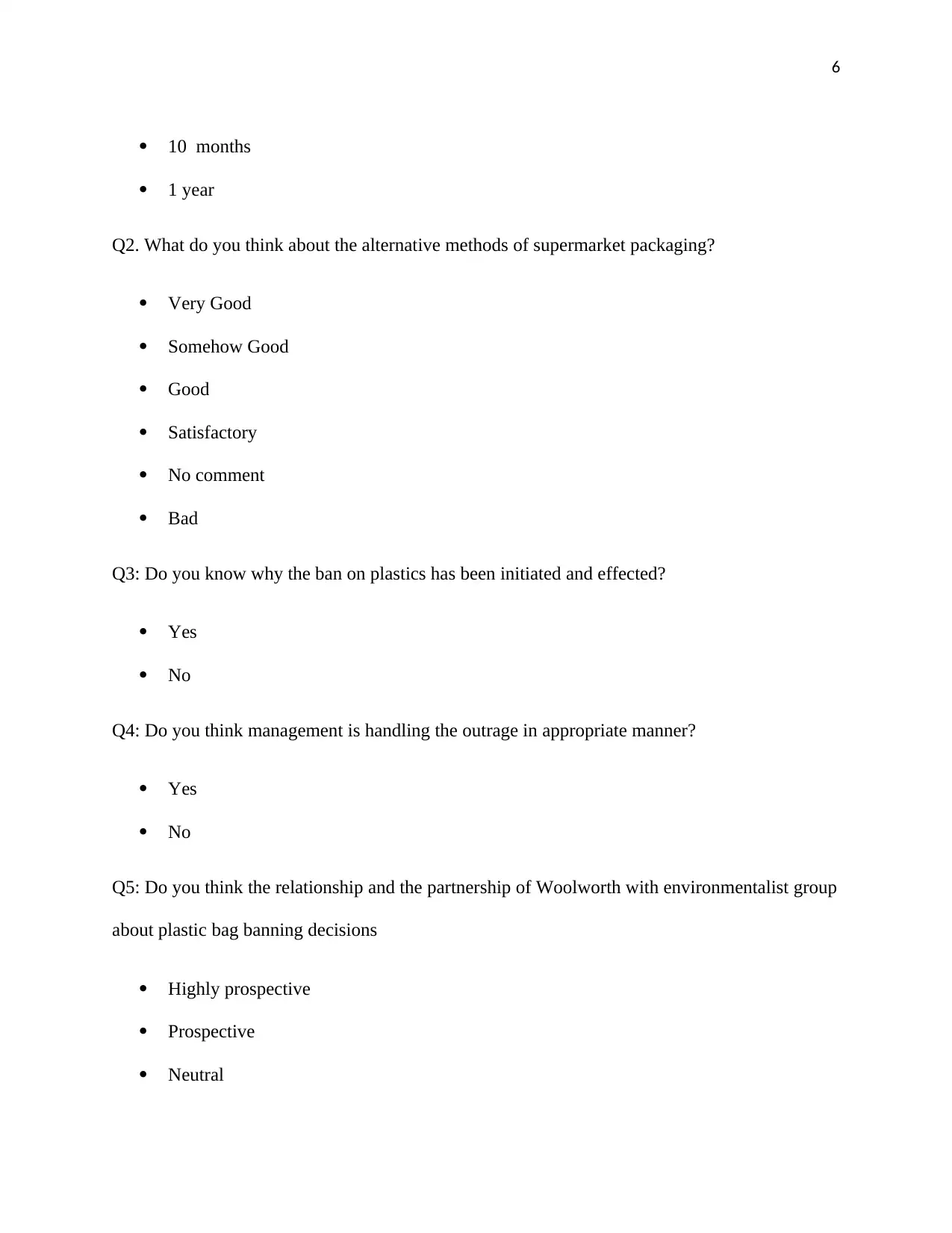
6
10 months
1 year
Q2. What do you think about the alternative methods of supermarket packaging?
Very Good
Somehow Good
Good
Satisfactory
No comment
Bad
Q3: Do you know why the ban on plastics has been initiated and effected?
Yes
No
Q4: Do you think management is handling the outrage in appropriate manner?
Yes
No
Q5: Do you think the relationship and the partnership of Woolworth with environmentalist group
about plastic bag banning decisions
Highly prospective
Prospective
Neutral
10 months
1 year
Q2. What do you think about the alternative methods of supermarket packaging?
Very Good
Somehow Good
Good
Satisfactory
No comment
Bad
Q3: Do you know why the ban on plastics has been initiated and effected?
Yes
No
Q4: Do you think management is handling the outrage in appropriate manner?
Yes
No
Q5: Do you think the relationship and the partnership of Woolworth with environmentalist group
about plastic bag banning decisions
Highly prospective
Prospective
Neutral
⊘ This is a preview!⊘
Do you want full access?
Subscribe today to unlock all pages.

Trusted by 1+ million students worldwide
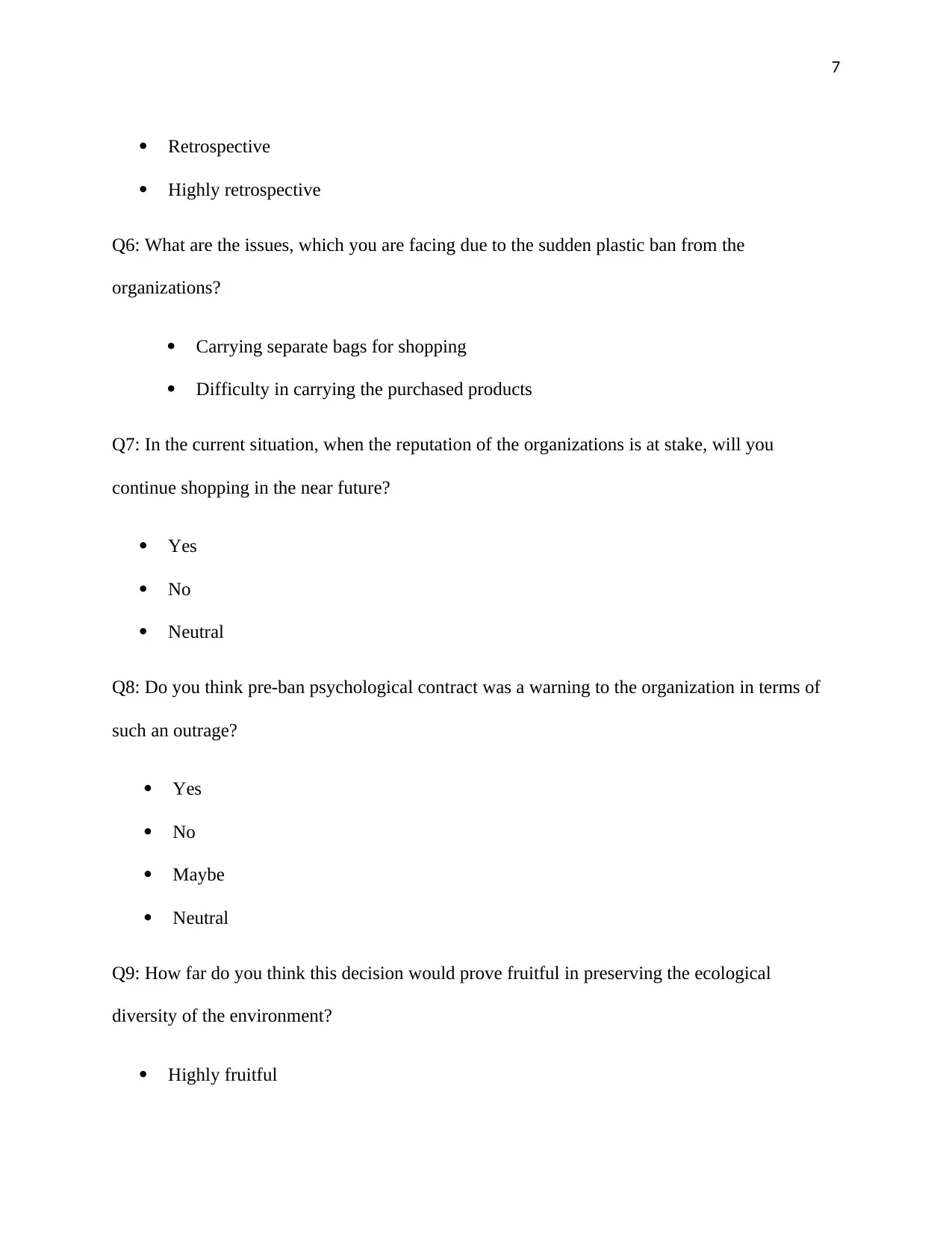
7
Retrospective
Highly retrospective
Q6: What are the issues, which you are facing due to the sudden plastic ban from the
organizations?
Carrying separate bags for shopping
Difficulty in carrying the purchased products
Q7: In the current situation, when the reputation of the organizations is at stake, will you
continue shopping in the near future?
Yes
No
Neutral
Q8: Do you think pre-ban psychological contract was a warning to the organization in terms of
such an outrage?
Yes
No
Maybe
Neutral
Q9: How far do you think this decision would prove fruitful in preserving the ecological
diversity of the environment?
Highly fruitful
Retrospective
Highly retrospective
Q6: What are the issues, which you are facing due to the sudden plastic ban from the
organizations?
Carrying separate bags for shopping
Difficulty in carrying the purchased products
Q7: In the current situation, when the reputation of the organizations is at stake, will you
continue shopping in the near future?
Yes
No
Neutral
Q8: Do you think pre-ban psychological contract was a warning to the organization in terms of
such an outrage?
Yes
No
Maybe
Neutral
Q9: How far do you think this decision would prove fruitful in preserving the ecological
diversity of the environment?
Highly fruitful
Paraphrase This Document
Need a fresh take? Get an instant paraphrase of this document with our AI Paraphraser
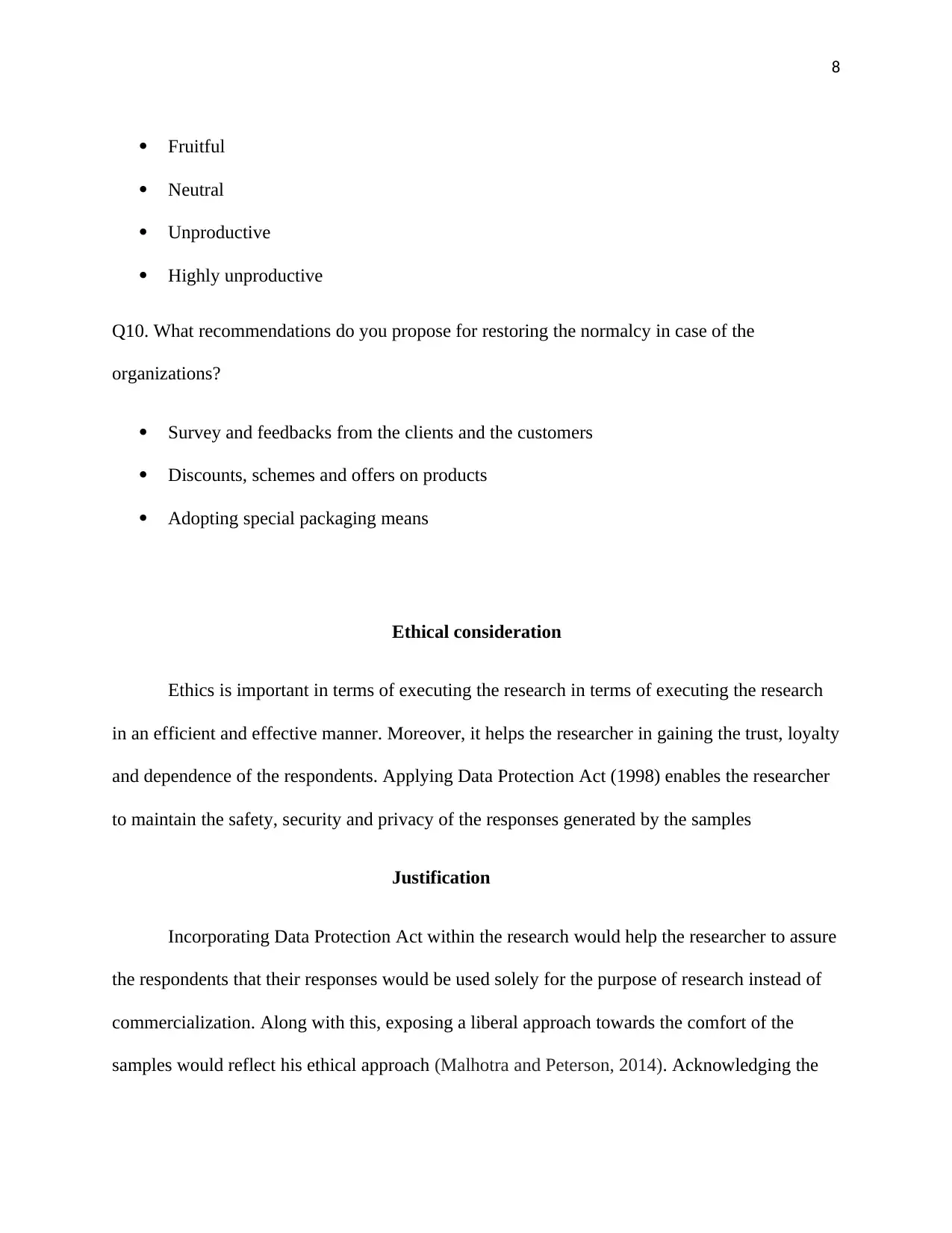
8
Fruitful
Neutral
Unproductive
Highly unproductive
Q10. What recommendations do you propose for restoring the normalcy in case of the
organizations?
Survey and feedbacks from the clients and the customers
Discounts, schemes and offers on products
Adopting special packaging means
Ethical consideration
Ethics is important in terms of executing the research in terms of executing the research
in an efficient and effective manner. Moreover, it helps the researcher in gaining the trust, loyalty
and dependence of the respondents. Applying Data Protection Act (1998) enables the researcher
to maintain the safety, security and privacy of the responses generated by the samples
Justification
Incorporating Data Protection Act within the research would help the researcher to assure
the respondents that their responses would be used solely for the purpose of research instead of
commercialization. Along with this, exposing a liberal approach towards the comfort of the
samples would reflect his ethical approach (Malhotra and Peterson, 2014). Acknowledging the
Fruitful
Neutral
Unproductive
Highly unproductive
Q10. What recommendations do you propose for restoring the normalcy in case of the
organizations?
Survey and feedbacks from the clients and the customers
Discounts, schemes and offers on products
Adopting special packaging means
Ethical consideration
Ethics is important in terms of executing the research in terms of executing the research
in an efficient and effective manner. Moreover, it helps the researcher in gaining the trust, loyalty
and dependence of the respondents. Applying Data Protection Act (1998) enables the researcher
to maintain the safety, security and privacy of the responses generated by the samples
Justification
Incorporating Data Protection Act within the research would help the researcher to assure
the respondents that their responses would be used solely for the purpose of research instead of
commercialization. Along with this, exposing a liberal approach towards the comfort of the
samples would reflect his ethical approach (Malhotra and Peterson, 2014). Acknowledging the
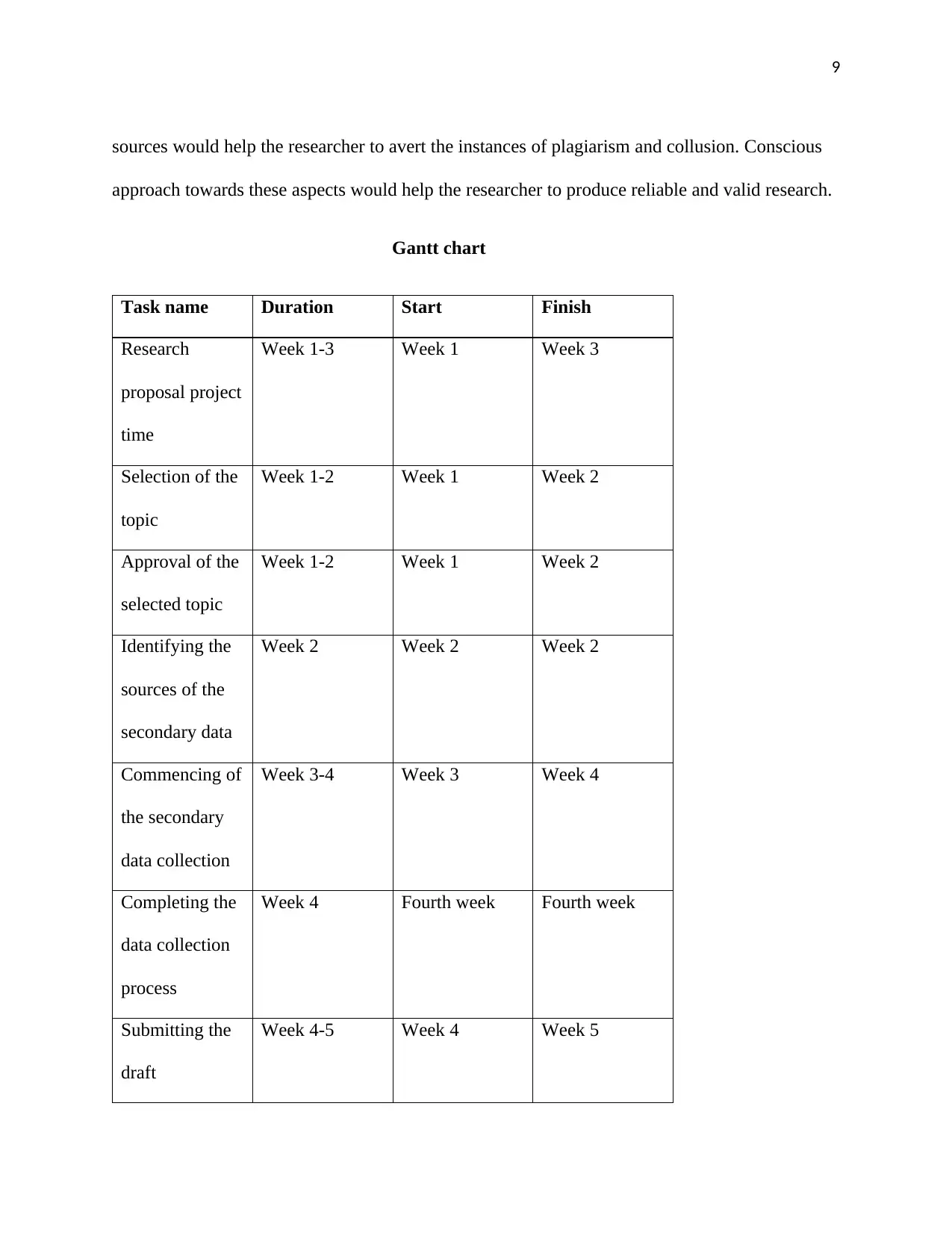
9
sources would help the researcher to avert the instances of plagiarism and collusion. Conscious
approach towards these aspects would help the researcher to produce reliable and valid research.
Gantt chart
Task name Duration Start Finish
Research
proposal project
time
Week 1-3 Week 1 Week 3
Selection of the
topic
Week 1-2 Week 1 Week 2
Approval of the
selected topic
Week 1-2 Week 1 Week 2
Identifying the
sources of the
secondary data
Week 2 Week 2 Week 2
Commencing of
the secondary
data collection
Week 3-4 Week 3 Week 4
Completing the
data collection
process
Week 4 Fourth week Fourth week
Submitting the
draft
Week 4-5 Week 4 Week 5
sources would help the researcher to avert the instances of plagiarism and collusion. Conscious
approach towards these aspects would help the researcher to produce reliable and valid research.
Gantt chart
Task name Duration Start Finish
Research
proposal project
time
Week 1-3 Week 1 Week 3
Selection of the
topic
Week 1-2 Week 1 Week 2
Approval of the
selected topic
Week 1-2 Week 1 Week 2
Identifying the
sources of the
secondary data
Week 2 Week 2 Week 2
Commencing of
the secondary
data collection
Week 3-4 Week 3 Week 4
Completing the
data collection
process
Week 4 Fourth week Fourth week
Submitting the
draft
Week 4-5 Week 4 Week 5
⊘ This is a preview!⊘
Do you want full access?
Subscribe today to unlock all pages.

Trusted by 1+ million students worldwide
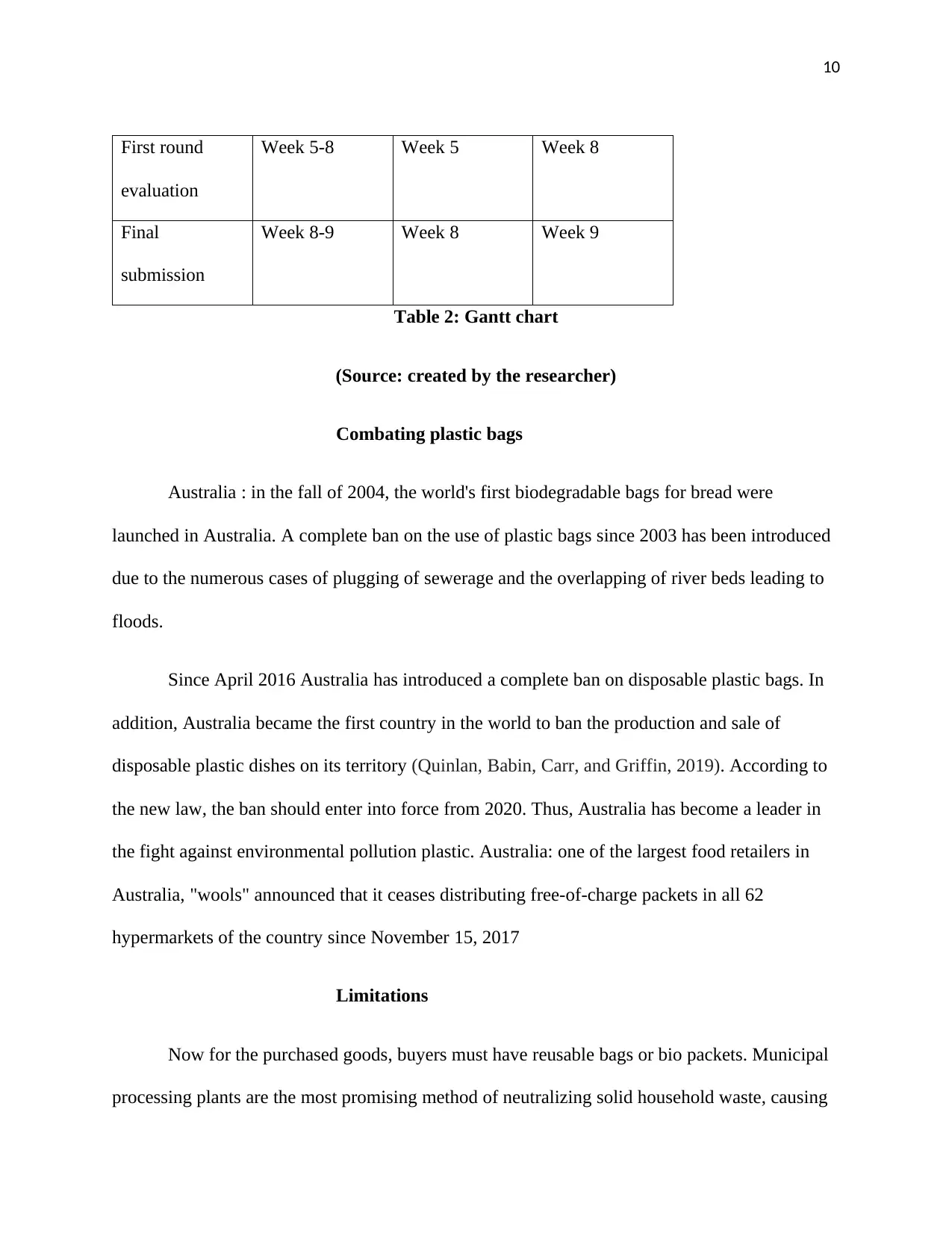
10
First round
evaluation
Week 5-8 Week 5 Week 8
Final
submission
Week 8-9 Week 8 Week 9
Table 2: Gantt chart
(Source: created by the researcher)
Combating plastic bags
Australia : in the fall of 2004, the world's first biodegradable bags for bread were
launched in Australia. A complete ban on the use of plastic bags since 2003 has been introduced
due to the numerous cases of plugging of sewerage and the overlapping of river beds leading to
floods.
Since April 2016 Australia has introduced a complete ban on disposable plastic bags. In
addition, Australia became the first country in the world to ban the production and sale of
disposable plastic dishes on its territory (Quinlan, Babin, Carr, and Griffin, 2019). According to
the new law, the ban should enter into force from 2020. Thus, Australia has become a leader in
the fight against environmental pollution plastic. Australia: one of the largest food retailers in
Australia, "wools" announced that it ceases distributing free-of-charge packets in all 62
hypermarkets of the country since November 15, 2017
Limitations
Now for the purchased goods, buyers must have reusable bags or bio packets. Municipal
processing plants are the most promising method of neutralizing solid household waste, causing
First round
evaluation
Week 5-8 Week 5 Week 8
Final
submission
Week 8-9 Week 8 Week 9
Table 2: Gantt chart
(Source: created by the researcher)
Combating plastic bags
Australia : in the fall of 2004, the world's first biodegradable bags for bread were
launched in Australia. A complete ban on the use of plastic bags since 2003 has been introduced
due to the numerous cases of plugging of sewerage and the overlapping of river beds leading to
floods.
Since April 2016 Australia has introduced a complete ban on disposable plastic bags. In
addition, Australia became the first country in the world to ban the production and sale of
disposable plastic dishes on its territory (Quinlan, Babin, Carr, and Griffin, 2019). According to
the new law, the ban should enter into force from 2020. Thus, Australia has become a leader in
the fight against environmental pollution plastic. Australia: one of the largest food retailers in
Australia, "wools" announced that it ceases distributing free-of-charge packets in all 62
hypermarkets of the country since November 15, 2017
Limitations
Now for the purchased goods, buyers must have reusable bags or bio packets. Municipal
processing plants are the most promising method of neutralizing solid household waste, causing
Paraphrase This Document
Need a fresh take? Get an instant paraphrase of this document with our AI Paraphraser
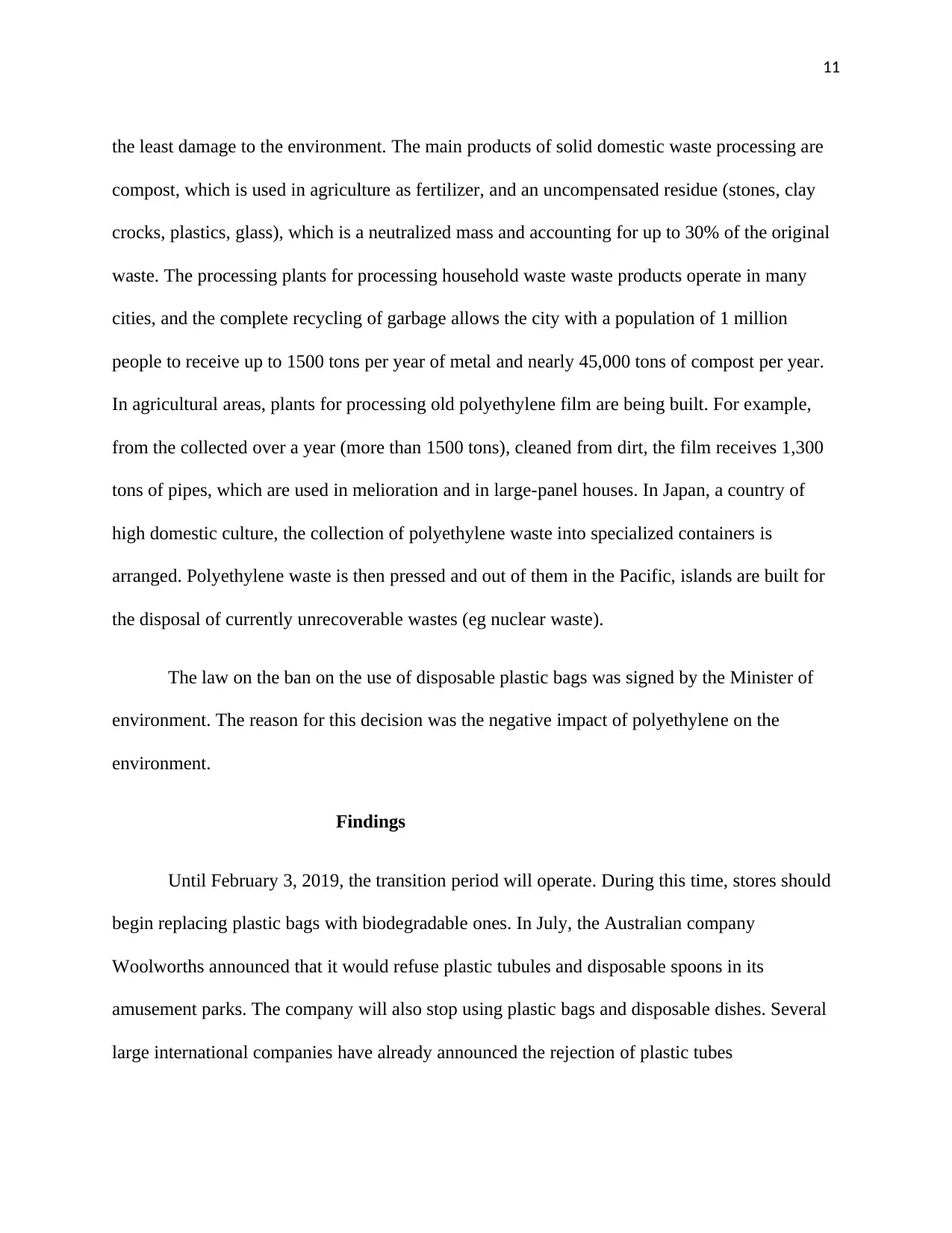
11
the least damage to the environment. The main products of solid domestic waste processing are
compost, which is used in agriculture as fertilizer, and an uncompensated residue (stones, clay
crocks, plastics, glass), which is a neutralized mass and accounting for up to 30% of the original
waste. The processing plants for processing household waste waste products operate in many
cities, and the complete recycling of garbage allows the city with a population of 1 million
people to receive up to 1500 tons per year of metal and nearly 45,000 tons of compost per year.
In agricultural areas, plants for processing old polyethylene film are being built. For example,
from the collected over a year (more than 1500 tons), cleaned from dirt, the film receives 1,300
tons of pipes, which are used in melioration and in large-panel houses. In Japan, a country of
high domestic culture, the collection of polyethylene waste into specialized containers is
arranged. Polyethylene waste is then pressed and out of them in the Pacific, islands are built for
the disposal of currently unrecoverable wastes (eg nuclear waste).
The law on the ban on the use of disposable plastic bags was signed by the Minister of
environment. The reason for this decision was the negative impact of polyethylene on the
environment.
Findings
Until February 3, 2019, the transition period will operate. During this time, stores should
begin replacing plastic bags with biodegradable ones. In July, the Australian company
Woolworths announced that it would refuse plastic tubules and disposable spoons in its
amusement parks. The company will also stop using plastic bags and disposable dishes. Several
large international companies have already announced the rejection of plastic tubes
the least damage to the environment. The main products of solid domestic waste processing are
compost, which is used in agriculture as fertilizer, and an uncompensated residue (stones, clay
crocks, plastics, glass), which is a neutralized mass and accounting for up to 30% of the original
waste. The processing plants for processing household waste waste products operate in many
cities, and the complete recycling of garbage allows the city with a population of 1 million
people to receive up to 1500 tons per year of metal and nearly 45,000 tons of compost per year.
In agricultural areas, plants for processing old polyethylene film are being built. For example,
from the collected over a year (more than 1500 tons), cleaned from dirt, the film receives 1,300
tons of pipes, which are used in melioration and in large-panel houses. In Japan, a country of
high domestic culture, the collection of polyethylene waste into specialized containers is
arranged. Polyethylene waste is then pressed and out of them in the Pacific, islands are built for
the disposal of currently unrecoverable wastes (eg nuclear waste).
The law on the ban on the use of disposable plastic bags was signed by the Minister of
environment. The reason for this decision was the negative impact of polyethylene on the
environment.
Findings
Until February 3, 2019, the transition period will operate. During this time, stores should
begin replacing plastic bags with biodegradable ones. In July, the Australian company
Woolworths announced that it would refuse plastic tubules and disposable spoons in its
amusement parks. The company will also stop using plastic bags and disposable dishes. Several
large international companies have already announced the rejection of plastic tubes
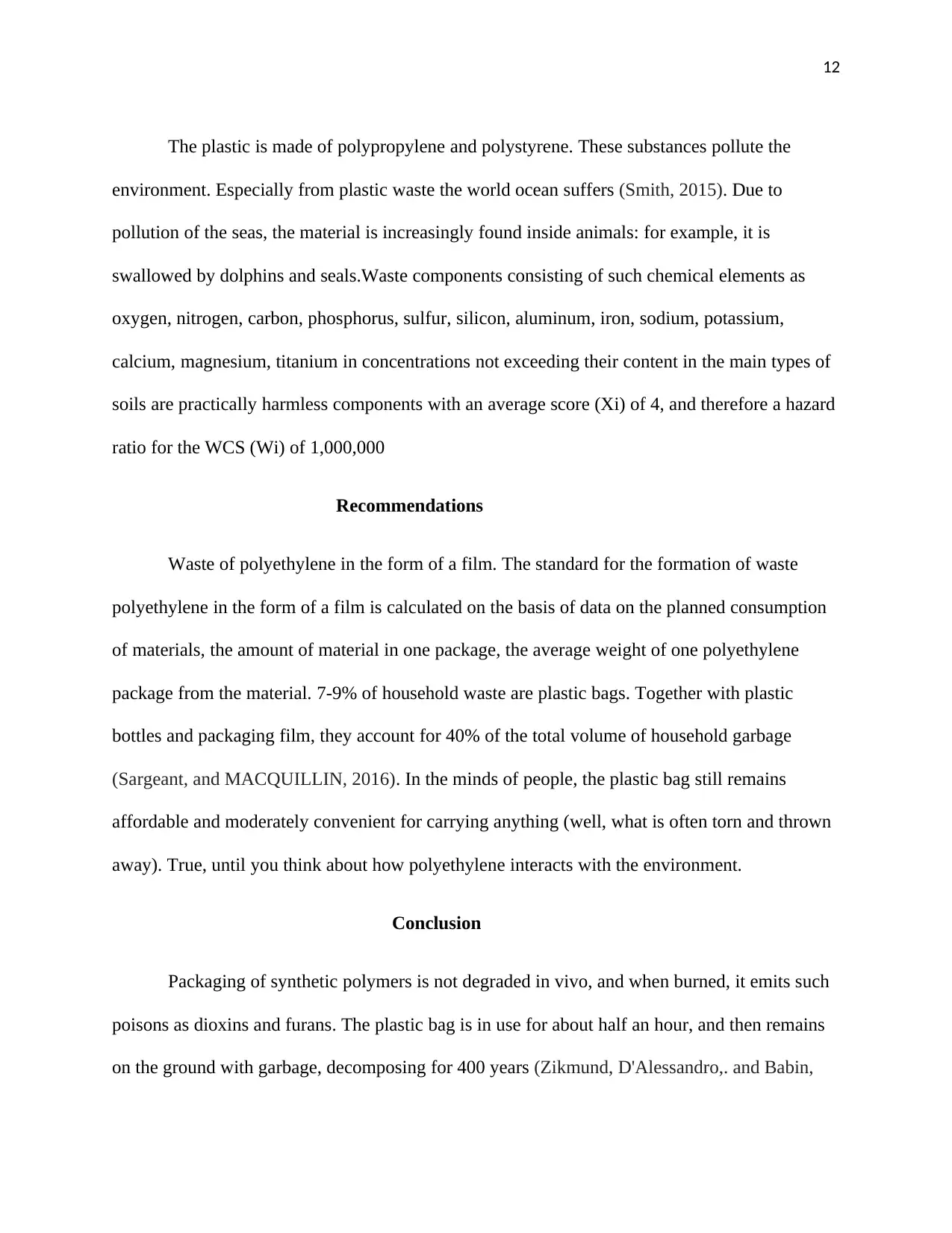
12
The plastic is made of polypropylene and polystyrene. These substances pollute the
environment. Especially from plastic waste the world ocean suffers (Smith, 2015). Due to
pollution of the seas, the material is increasingly found inside animals: for example, it is
swallowed by dolphins and seals.Waste components consisting of such chemical elements as
oxygen, nitrogen, carbon, phosphorus, sulfur, silicon, aluminum, iron, sodium, potassium,
calcium, magnesium, titanium in concentrations not exceeding their content in the main types of
soils are practically harmless components with an average score (Xi) of 4, and therefore a hazard
ratio for the WCS (Wi) of 1,000,000
Recommendations
Waste of polyethylene in the form of a film. The standard for the formation of waste
polyethylene in the form of a film is calculated on the basis of data on the planned consumption
of materials, the amount of material in one package, the average weight of one polyethylene
package from the material. 7-9% of household waste are plastic bags. Together with plastic
bottles and packaging film, they account for 40% of the total volume of household garbage
(Sargeant, and MACQUILLIN, 2016). In the minds of people, the plastic bag still remains
affordable and moderately convenient for carrying anything (well, what is often torn and thrown
away). True, until you think about how polyethylene interacts with the environment.
Conclusion
Packaging of synthetic polymers is not degraded in vivo, and when burned, it emits such
poisons as dioxins and furans. The plastic bag is in use for about half an hour, and then remains
on the ground with garbage, decomposing for 400 years (Zikmund, D'Alessandro,. and Babin,
The plastic is made of polypropylene and polystyrene. These substances pollute the
environment. Especially from plastic waste the world ocean suffers (Smith, 2015). Due to
pollution of the seas, the material is increasingly found inside animals: for example, it is
swallowed by dolphins and seals.Waste components consisting of such chemical elements as
oxygen, nitrogen, carbon, phosphorus, sulfur, silicon, aluminum, iron, sodium, potassium,
calcium, magnesium, titanium in concentrations not exceeding their content in the main types of
soils are practically harmless components with an average score (Xi) of 4, and therefore a hazard
ratio for the WCS (Wi) of 1,000,000
Recommendations
Waste of polyethylene in the form of a film. The standard for the formation of waste
polyethylene in the form of a film is calculated on the basis of data on the planned consumption
of materials, the amount of material in one package, the average weight of one polyethylene
package from the material. 7-9% of household waste are plastic bags. Together with plastic
bottles and packaging film, they account for 40% of the total volume of household garbage
(Sargeant, and MACQUILLIN, 2016). In the minds of people, the plastic bag still remains
affordable and moderately convenient for carrying anything (well, what is often torn and thrown
away). True, until you think about how polyethylene interacts with the environment.
Conclusion
Packaging of synthetic polymers is not degraded in vivo, and when burned, it emits such
poisons as dioxins and furans. The plastic bag is in use for about half an hour, and then remains
on the ground with garbage, decomposing for 400 years (Zikmund, D'Alessandro,. and Babin,
⊘ This is a preview!⊘
Do you want full access?
Subscribe today to unlock all pages.

Trusted by 1+ million students worldwide
1 out of 15
Your All-in-One AI-Powered Toolkit for Academic Success.
+13062052269
info@desklib.com
Available 24*7 on WhatsApp / Email
![[object Object]](/_next/static/media/star-bottom.7253800d.svg)
Unlock your academic potential
Copyright © 2020–2025 A2Z Services. All Rights Reserved. Developed and managed by ZUCOL.

